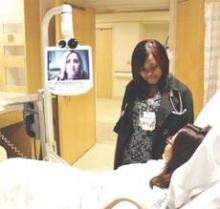Physicians who practice telemedicine have a lot to consider, including state laws, payment issues, and licensing regulations. But one overlooked area may pose the greatest risk of all: medical liability.
As the practice of telemedicine continues to grow, so do the legal risks associated with virtual care, said Dr. Joseph P. McMenamin, an emergency physician and health law defense attorney based in Richmond, Va.
“With good reason, there is a concern that as this form of care expands, claims against physicians will increase,” Dr. McMenamin said. “That’s almost inevitable, given how our society looks at litigation and how willing we are to sue our doctors. If you’re a plaintiffs’ attorney, you might be attracted to cases of this kind – partly because jurors may fear the unknown, and they may view [telemedicine] with some concern and suspicion.”
Telemedicine can fuel a wide spectrum of legal dangers, including malpractice, product liability claims, data exposure, and credentialing risks. Making matters more complicated: No uniform standard of care exists for telemedicine when it comes to medical malpractice, said René Y. Quashie, a Washington health law attorney who specializes in telemedicine and e-health practices.
“There are a lot of unanswered questions, including the prevailing standard of care,” Mr. Quashie explained. “Can we use the standard of care that we use for services provided in person for telehealth consults? Informed consent – does that process need to change? There are a lot of unanswered issues, which can only be resolved after a number of cases” are decided in the courts.
Physicians who practice telemedicine should consider legal risks associated with patient and staff privacy, inaccuracies in self-reporting, and symptoms that are more accurately diagnosed in person, said Richard F. Cahill, vice president and associate general counsel for the Doctors Company, a national medical liability insurer.
During 2007-2014, the Doctors Company had 11 claims that closed related to telemedicine, according to data provided by Mr. Cahill.
The majority of claims resulted from the remote reading of x-rays and other films by health providers, usually from home, and the remote reading of fetal monitor strips by physicians when outside of the hospital. Two of the cases were associated with attempts to diagnose a patient via telemedicine. Of the claims, six were diagnosis related, two alleged delay in treatment, two were related to improper performance of treatment, and one was associated with failure to order medication.
“The challenges of remote communications made it difficult to formulate the correct diagnosis due to limitations of radiology resolution, delayed readings of radiographs, or limits on fetal monitor strips,” said Darrell Ranum, vice president of patient safety and risk management for the Doctors Company. “Delays in treatment were closely related to delayed diagnosis. Radiologists did not receive a request for an interpretation, or they did not know that it was an emergency, so they did not provide a rapid turnaround report.”
While telemedicine claims have been low so far, a rise in the number of patient contacts, regardless of modality, may increase the risk of adverse consequences, Mr. Cahill cautioned.
“Because telemedicine is relatively new, and it takes 3-4 years for a claim to work its way through the system, we may see more cases in the future in which telemedicine is a factor,” he predicted.
Other lawsuits could arise from claims that physicians had access to telemedicine but failed to use the technology to properly treat a patient, Mr. Quashie said. Product liability claims also pose a threat, added Dr. McMenamin, who is part of the Legal Resource Team at the Robert J. Waters Center for Telehealth & e-Health Law (CTeL). Such accusations stem from equipment that malfunctioned or failed to work as indicated.
Varying credentialing rules also can trip up doctors who work virtually. Physicians at a large academic medical center, for example, could face trouble if they aren’t credentialed at the small rural hospital where a patient is located, Dr. McMenamin said. He noted that Medicare modified its telemedicine encounter rules several years ago, making it possible for rural hospitals to accept the credentialing process of the health center where the specialist is located. However, other criteria must be met for the telehealth encounter to occur.



